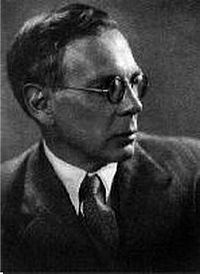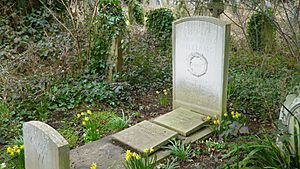Charles Williams (British writer) facts for kids
Charles Walter Stansby Williams (born September 20, 1886 – died May 15, 1945) was a British writer. He wrote poems, novels, plays, and books about religion and literature. He spent most of his life in London, where he was born. In 1939, he moved to Oxford with the publishing company he worked for. He passed away early and was buried there.
Contents
Early Life and School
Charles Williams was born in London in 1886. He was the only son of Walter and Mary Williams. His father, Walter, was a journalist who wrote for popular magazines. His mother, Mary, used to be a milliner (someone who makes and sells hats). Charles also had a younger sister named Edith.
His family did not have much money. In 1894, they moved to St Albans in Hertfordshire. Charles lived there until he got married in 1917.
Charles went to St Albans School. He won a scholarship to University College London. However, he had to leave in 1904 because he could not pay the school fees. He did not get a degree.
Working Life and Books
In 1904, Charles Williams started working at a bookshop. In 1908, he got a job at the Oxford University Press (OUP). This is a very famous publishing company. He started as a helper who checked texts for errors. He quickly became an editor. He worked at OUP until he died in 1945. One of his big achievements was publishing the first English version of books by Søren Kierkegaard.
Charles Williams is best known for his novels. But he also wrote many other things. He wrote poems, plays, history books, and biographies (life stories of people). He also wrote many book reviews.
Some of his most famous novels are War in Heaven (1930) and Descent into Hell (1937). Another famous writer, T. S. Eliot, called Williams's novels "supernatural thrillers." This is because they mix everyday life with spiritual or magical events. They also explore how power, even spiritual power, can be used for good or bad.
Unlike many other fantasy writers, Williams's fantasy stories happen in the real world. He is seen as one of the most important writers of "Christian fantasy" in the 1900s. Other famous Christian fantasy writers include C. S. Lewis and J. R. R. Tolkien.
W. H. Auden, another famous writer, loved Williams's book The Descent of the Dove (1939). This book was a history of the church. Williams also wrote a book about Dante called The Figure of Beatrice (1944). This book is still studied by experts today. Williams's work even inspired Dorothy L. Sayers to translate Dante's The Divine Comedy.
Williams thought his most important work was his poetry about King Arthur. He published two books of these poems: Taliessin through Logres (1938) and The Region of the Summer Stars (1944). He had more poems planned but did not finish them before he died.
Personal Life
In 1917, Charles Williams married his first love, Florence Conway. He had written a series of poems for her. These poems later became his first published book of poetry, The Silver Stair. Their son, Michael, was born in 1922.
Williams was a very dedicated member of the Church of England. He was known for being understanding of people who had doubts about faith. He believed it was important to have people who questioned things.
Many famous writers admired Charles Williams, including T. S. Eliot and W. H. Auden. But his biggest admirer was probably C. S. Lewis. Lewis's novel That Hideous Strength (1945) was partly inspired by Williams and his books.
Williams and Lewis became friends after reading each other's books. They both wrote letters to congratulate each other on their work. These letters crossed in the mail and started a lasting friendship.
When World War II began in 1939, the Oxford University Press moved its offices from London to Oxford. Williams did not want to leave London, and his wife stayed there. He wrote nearly 700 letters to his wife during the war. These letters were mostly love letters.
Moving to Oxford allowed Williams to join a famous literary group called the Inklings. This group included C. S. Lewis and J. R. R. Tolkien. In this group, Williams read parts of his last novel, All Hallows' Eve. He also heard Tolkien read early parts of The Lord of the Rings. The Inklings met in Lewis's rooms and at The Eagle and Child pub in Oxford. While in Oxford, Williams also gave talks at the university and received an honorary degree.
Charles Williams is buried in Holywell Cemetery in Oxford. His gravestone says "poet" and then "Under the Mercy." This was a phrase he often used himself.
Ideas About Faith
Charles Williams had special ideas about faith. One of his main ideas was called "co-inherence." This idea describes how everything in God's creation is connected and depends on each other. It's like a big web of relationships. For Williams, this included how people are connected to each other and to God. He believed that salvation (being saved) was not something you could do alone. He said, "The thread of the love of God was strong enough to save you and all the others, but not strong enough to save you alone."
He also thought that falling in love was a way of seeing the other person as God sees them.
Selected Works
Fiction
He is writing that sort of book in which we begin by saying, let us suppose that this everyday world were at some one point invaded by the marvellous.
- 1930: War in Heaven – The Holy Grail appears in a small town. People try to protect it or use its power.
- 1930: Many Dimensions – A special stone allows people to travel through space and time.
- 1931: The Place of the Lion – Magical ideas start to appear in an English town, causing chaos.
- 1932: The Greater Trumps – An old Tarot deck helps people see across space and time and create storms.
- 1945: All Hallows' Eve – This story follows two women after they die and how they interact with the living.
Plays
- 1930: A Myth of Shakespeare
- 1936: Thomas Cranmer of Canterbury
- 1939: The House by the Stable
Poetry
- 1912: The Silver Stair
- 1938: Taliessin through Logres
- 1944: The Region of the Summer Stars
Theology (Books about Faith)
- 1938: He Came Down from Heaven
- 1939: The Descent of the Dove: A Short History of the Holy Spirit in the Church
- 1941: Witchcraft
Literary Criticism (Books about Literature)
- 1932: The English Poetic Mind
- 1943: The Figure of Beatrice (about Dante)
Biography (Life Stories)
- 1933: Bacon
- 1934: James I
- 1936: Queen Elizabeth
- 1937: Henry VII
See also
 In Spanish: Charles Williams (escritor británico) para niños
In Spanish: Charles Williams (escritor británico) para niños



